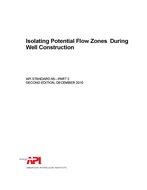Click here to purchase
This document contains best practices for zone isolation in wells to prevent annular pressure and/or flow through or past pressure-containment barriers that are installed and verified during well construction. Barriers that seal wellbore and formation pressures or flows may include temporary pressure-containment barriers like hydrostatic head pressure during cement curing and permananet ones such as mechanical seals, shoe formations, and cement. Other well construction (well design, drilling, leak-off tests, etc.) practices that may affect barrier sealing performance will be mentioned along with methods to help ensure positive effects or to minimize any negative ones.
The objective of this guideline are two-fold. The first is to help orevent and/or control flows just prior to, during, and after primary cementing operations to install or “set” casing and liner pipe strings in wells. Some of these flows have caused well control incidents that are veyr serious problem. They threaten the safety of personnel, the environment, and the drilling rigs themselves. The second objective is to help prevent sustained casing pressures (SCP), also a serious industry problem.
A detailed background and technology review are in Annex A. Historical data, perspectives, studies, statistics, lessons learned, etc. are included. All this information has been written to help explain how some practices work, have become proven or invalidated, or had performance limitations placed upon their application.
Product Details
- Edition:
- 2nd
- Published:
- 12/01/2010
- Number of Pages:
- 96
- File Size:
- 1 file , 1.2 MB
- Product Code(s):
- G65202, G65202, G65202
- Note:
- This product is unavailable in Cuba, Iran, North Korea, Syria
